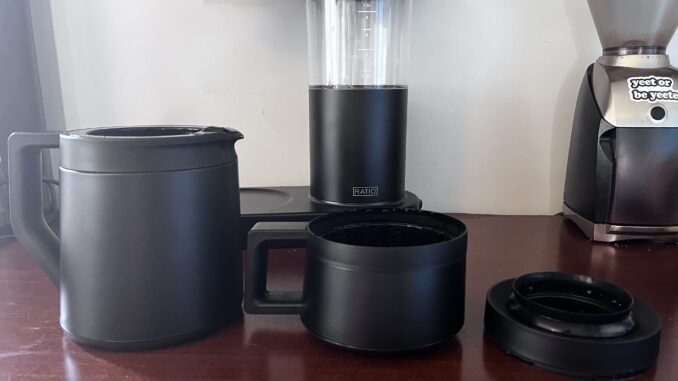
Use straightforward measurements to get your best brew with the Ratio 6 drip coffee brewer.
BY ANDREW HO
SPECIAL TO BARISTA MAGAZINE ONLINE
Photos by Andrew Ho
Brewing great coffee should be simple, as in: so simple, my half-awake brain should be able to stumble through it without breaking anything or hurting myself in the process. And not with just an average or acceptable brew; if it starts my day, it needs to be good.
Most modern home coffee setups aren’t so effortless, and ironically, automatic drip coffee brewers tend to be the worst offenders. The majority have too many scrolling knobs, dials, buttons, lights, weird sounds, superfluous “features,” and LED screens with options upon options for how, when, and where to brew your coffee.
I just want to press the button that makes the coffee—and that’s exactly what the Ratio 6 offers. It’s beautifully simple, and most importantly, it brews great coffee.
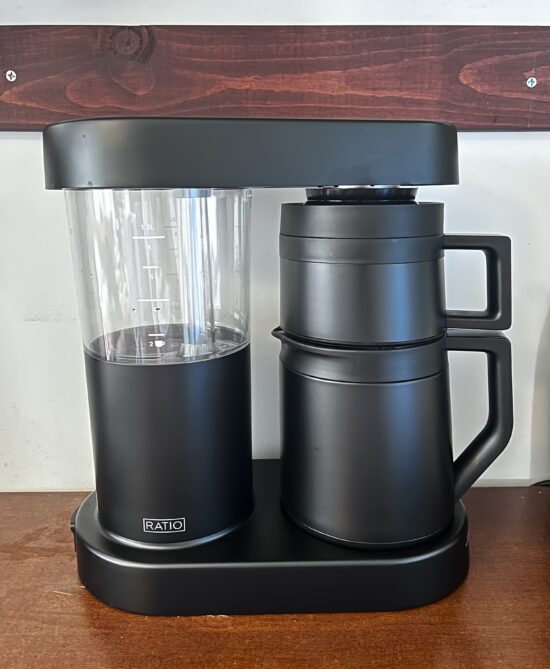
Less Plastic, More Craftsmanship
Released in 2020, the Ratio 6 is the latest model of coffee machines from Portland, Ore.-based company Ratio. Upon first look, it is undeniably elegant. With its clean lines and sharp, modern silhouette, it’s the kind of appliance that you’re happy to let take up room on your kitchen counter just so you can show it off. It’s clear that there was real thought and intention behind each element of the Ratio 6’s design, and this is most evident in the materials used.
The main body of the Ratio 6 is made of formed stainless steel, and mine came in a handsome brushed matte black finish. The water tank is made of a BPA-free polymer, but the supply line that runs water from the tank to the stainless steel is actually made from hand-blown borosilicate glass. This prevents very hot water from coming into contact with as little plastic as possible, no doubt improving the longevity of the Ratio 6 and making it easier to clean.
Pump-Free Brewing
And an interesting note about the water delivery system in the Ratio: There aren’t any pumps involved, which, according to Ratio, tend to be the first parts that fail in a coffee machine.
Instead, water is quickly heated (presumably in a sealed chamber) and the resulting pressure sends the water up through the supply line, similar to how a siphon brewer works.
Overall, everything feels very premium and precise, even down to the water tank lid, which is also made of carefully machined stainless steel and has a lovely, hefty weight in the hand.
SCA Gold Cup Certified
The most interesting part about the Ratio 6’s design is its stacking carafe, filter basket, and heat shield setup. At the base of the stack you have the carafe; on top of this sits the filter basket, which holds a flat-bottomed filter (a four-to-six-cup flat-bottomed Melitta filter should be compatible), and on top of that sits the heat shield. It feels like a lot of parts at first, but they fit together well and don’t feel extraneous or clunky. There’s also a lid for the carafe and a base to set the filter basket on to catch any drips.
This brewing stack, in addition to even more premium materials in the pricier flagship model (which has less plastic, more glass and wood accents), is what mainly sets the Ratio 6 apart from the Ratio 8. But when it comes to better coffee brewing, my vote is for the Ratio 6.
That’s because the Ratio 6 is the only brewer in the Ratio lineup that’s earned an SCA Gold Cup certification. In order to be certified, brewers need to meet certain requirements, including using a closed brewing chamber and either a hot plate or a thermal carafe to hold coffee after brewing. Minimizing heat loss is one of the main hurdles when it comes to fully extracting coffee, so I think the addition of the heat shield and the overall closed brewing system—which is supposed to mimic a commercial coffee shop brewer—makes a huge difference when it comes to producing consistently tasty brews.
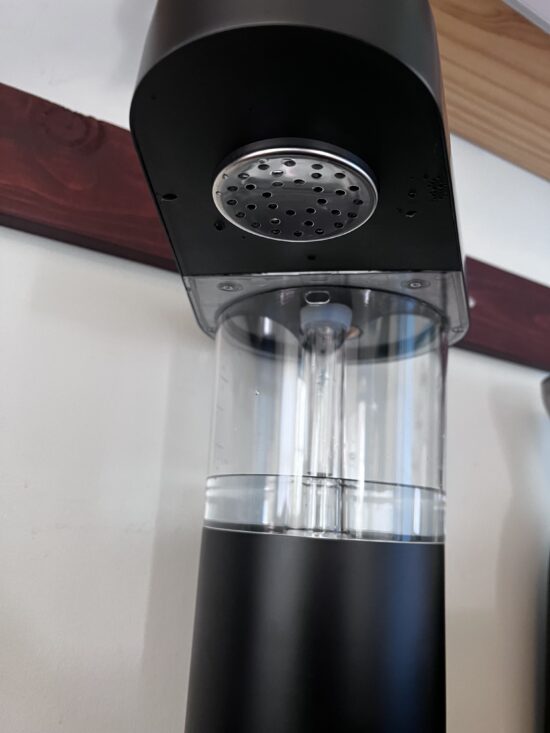
Nearly Perfect Brewing
Brewing with the Ratio 6 is, as I mentioned, dead simple. There’s literally only one button to press. This starts an initial bloom followed by the main brewing phase, and both are indicated by lights on the front of the machine. What’s important to note is that unlike most other brewers, the Ratio 6 will dispense all of the water held in the tank each time you brew. This means that you need to be accurate with the amount of water you add depending on how much coffee you want to make. And herein lies my first of only two complaints about the Ratio 6.
The water volume markings on the side of the tank are super inaccurate.
On the tank, there are lines indicating two, four, six, and eight cups. Firstly, why not just have the actual milliliters of water instead of arbitrary cup amounts? In fact, “1.3L” is printed alongside the eight-cup mark—just do it for the rest of them! Otherwise, I need to go into the manual and look up exactly how much water the Ratio thinks two cups of coffee needs, which happens to be 500 ml. Frustratingly, 500 ml of water comes nowhere close to lining up with the two-cup mark on the tank; actually, none of the markings line up with the amount of water they’re supposed to indicate. Ultimately, this isn’t the worst thing since I can always weigh the amount of water I want to use, but it feels like an unfortunate oversight.
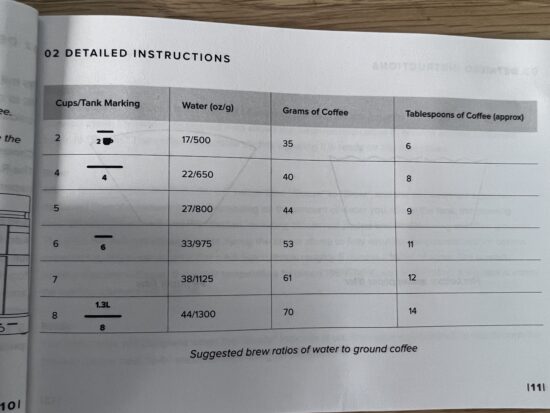
This brings me to my second concern. The included coffee ratios make no sense.
For a 500 ml brew, Ratio recommends 35 grams of coffee, which would be a 14.28:1 brew ratio. You would think that a four-cup brew would simply be double that, but instead, Ratio recommends 650 ml of water to 40 g of coffee, for a ratio of 16.25:1. The ratio randomly changes again for six cups; this time it’s 975 ml to 53g of coffee for a ratio of 18.39:1. Perhaps I’m missing something here, but my instincts tell me that brew ratios shouldn’t be changing so much from batch to batch. My advice would be to ignore the recommended brewing ratios and just use what you normally brew with. That’s what I’ve been doing, and the results have been excellent.
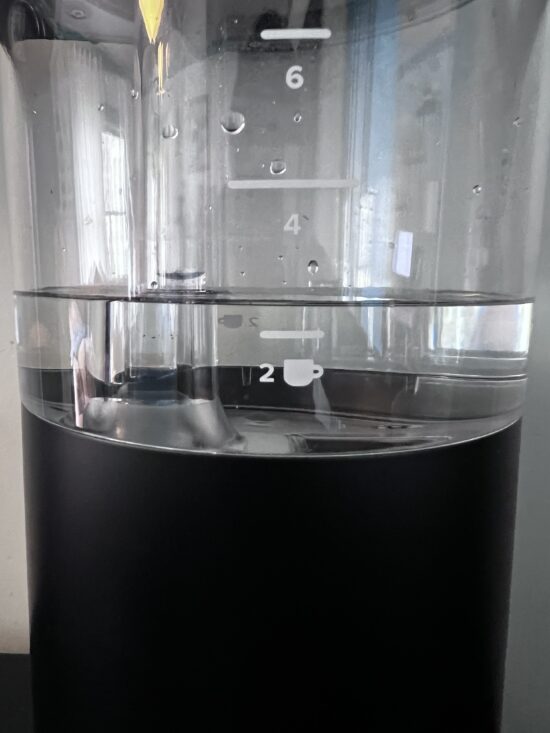
Closing Thoughts
The Ratio 6 may very well be the best automatic home coffee machine available right now; it’s certainly the best looking by far. It’s a pleasure to use, and I’m confident that it will hold up for many, many years of daily brewing. At $365 USD, it’s definitely not cheap, but it’s actually on par with other brewers like the Moccamaster Technivorm and Breville Precision Brewer, both of which I think the Ratio 6 outperforms. From the occasional coffee drinker to the most discerning specialty-coffee enthusiasts, the Ratio 6 should appeal to any coffee person who values both form and function.
ABOUT THE AUTHOR
Andrew Ho (he/him) is a coffee professional based in Portland, Ore. He enjoys cooking, endearing animal videos, and a juicy pourover on a daily basis.

